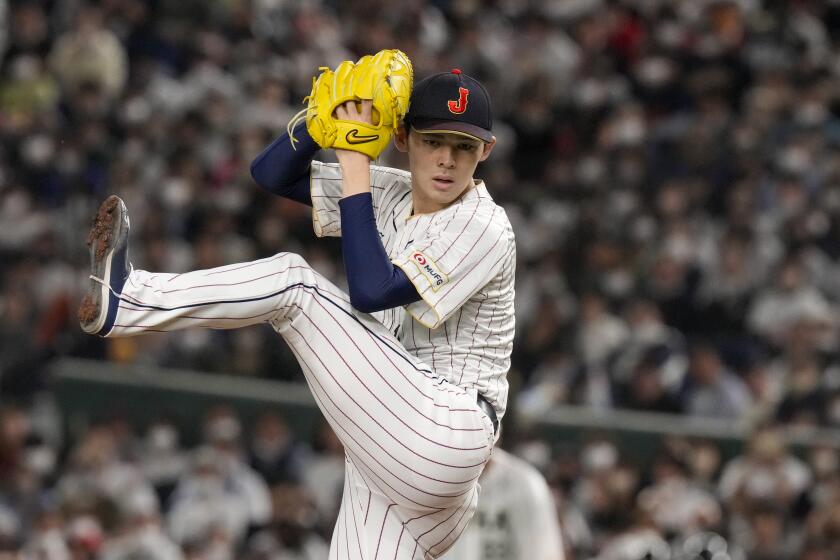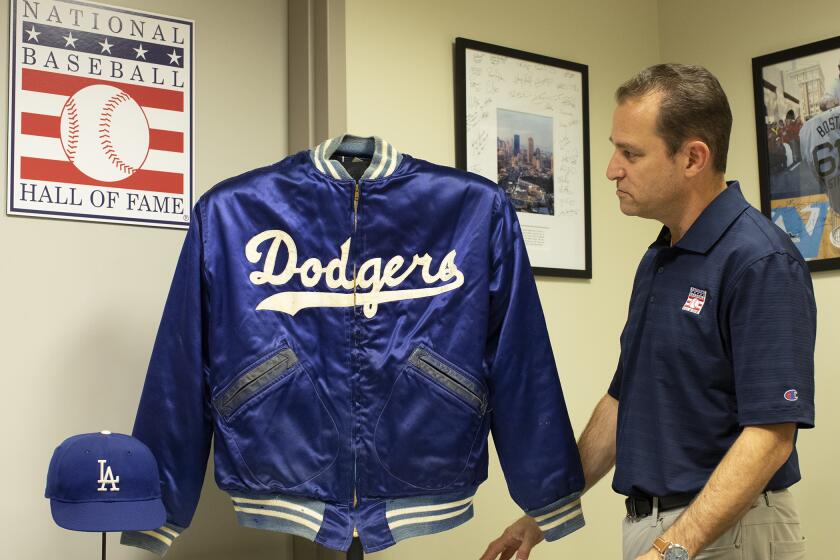For Rotisserie Baseball Fanatics, a Grand Sham
- Share via
April 3 was not a good day for local baseball fans. On that day Pedro Guerrero, the Dodgers’ star left fielder, ruptured a tendon in his left knee, causing fans throughout Southern California to bemoan his misfortune. But J. R. Williams probably reacted more strongly than most fans to the injury, which will keep Guerrero idle at least until July.
“I was really upset,” the 23-year-old computer operator recalled later. “I was shocked. I couldn’t believe it.
Contract for $7 a Year
here
“I hate to see any player get hurt,” Williams added, but his concern was not entirely selfless. Williams owns the “J. R. Ewings” of the Golden State League of Rotisserie Baseball Clubs; Guerrero, who hit 33 home runs last year and batted .320 for the Dodgers, was also the Ewings’ star. On April 1, Williams had signed Guerrero to one of the richest contracts in league history: $7 a year for three years.
Confused? You’ve never heard of Rotisserie Baseball or the Golden State League, let alone the J. R. Ewings? Don’t worry. Except in the hearts and minds of J. R. Williams and 10 friends, the Ewings exist only on paper.
Thousands of Fans
But how this league, and hundreds like it, exist in the minds of owners! Indeed, Rotisserie League Baseball (named after a Manhattan restaurant at which the first known league was conceived in January, 1980) has attracted thousands of baseball fans, causing some to lose sleep worrying about their players, others to run up large phone bills, and many--heresy among baseball fans--to root against the home team.
The object of such devotion, also known as “ghost” or “fantasy” baseball, is on its surface a disarmingly simple game. It has no board, no dice, no cards. It requires only imagination--and an incredibly detailed knowledge of baseball.
While rules vary somewhat from league to league (often being altered at winter meetings by “club officials,”) basically here is how it goes: Soon after baseball season begins, about 10 “owners” gather to select real players from major league teams. Each chooses 22 or 23 players, including eight pitchers, at auction or through a draft. As in major league baseball, the challenge is to evaluate players and assemble a balanced team.
Throughout the six-monthlong baseball season, owners trade, cut, and move players, measuring their success by the actual statistics of their players. In October, leagues use eight statistical categories, such as home runs (5 points in a typical league) and pitching victories (30 points for a starting pitcher, 20 for a reliever), to determine the best team. The top three split the money collected from the player auction or from entry fees. One local league, for example, charges $60 per team to enter and pays $350 to the top team, $150 to second place and $100 to third.
(The concept is not confined to baseball, and a handful of leagues play a similar game with pro football, using only offensive players. In one, the “Hollywood Football League,” owners chip in $500 apiece.)
If J. R. Williams’ reaction to Pedro Guerrero’s injury seems extreme, in context it is not at all so.
- Last summer, mononucleosis and hepatitis forced Matthew Irmas, owner of Matt’s Fat Bats in the Westwood Rotisserie League, to miss three months of work. But Irmas, 29, remained an active owner. “For three months I was completely consumed by baseball,” the Marina del Rey resident remembers. “I would wake up at 3:30 in the morning waiting for the paper to come.”
A fellow owner avoided that problem by subscribing to a computer data base that provides detailed baseball results. Now he can find out how his players did minutes after a game ends.
Penny Pincher League
- Donna Turner, 51, a banking consultant, owns the DT’s in the Penny Pincher League. The Torrance resident says her long-distance phone bill doubled last summer because she was calling major league teams for information.
Turner isn’t unique. According to Toby Zwikel, assistant publicity director for the Dodgers, the team received a number of calls from Rotisserie players asking about Guerrero. Zwikel says his office gets “too many” such calls: “They are a pain for us. We’re here 14 hours a day and more during the season. To answer those questions is just one more thing we have to do.”
“Being a baseball fan is one thing,” Donna Turner explains, “but to really let your fantasies go in a league is another. You get the ‘owners’ syndrome--you really think these players are yours. Your mind runs away.”
- Rotisserie leagues have made dedicated Dodger fans reconsider their loyalties. “You never watch a baseball game the same way again,” says Donald Drooker, 40, of Canoga Park, whose team, Donald’s Ducks, competes in the Bowling League of Rotisserie Baseball (a group of bowling industry managers and executives). “You could be a lifelong Dodger fan, but if you go to the stadium and one of your pitchers is pitching against the Dodgers, you root against the Dodgers.”
There are hundreds, perhaps thousands, of similar leagues. Ghost League Baseball, a San Francisco company selling computer software to run leagues, has responded to more than 1,000 inquiries about the program and a statistics service since both were introduced in February, says part-owner Jules Tygiel. Bantam Books’ Rotisserie League Baseball, a humorous guide, has 51,000 copies in print, and more than 400 leagues, including about 40 in Southern California, have paid $50 apiece to join the Rotisserie League Baseball Assn.
For their money, association members get a mixture of serious information (final major league rosters, lists of players by position) and humor that has from the beginning marked this game. At the end of each season, for example, the original Rotisserie Leaguers ritually pour Yoo-Hoo, a soft drink once endorsed by ex-New York Yankee catcher Yogi Berra, on their league champion; the association will send a can of Yoo-Hoo to any league that cannot obtain the syrupy chocolate beverage. Few, it seems, actually emulate the ritual.
With names like the the Wulfgang (owned by Steve Wulf) and the Sklar Gazers (Robert Sklar), the original league also spread a plague of puns that play on owners’ names. The J. R. Ewings compete against Harper’s Bizarre (Ben Harper), the Fuller Brushmen (Alan Fuller), and the Haskimos (Mike Haskins).
‘Fall in Love’
Devotees of Rotisserie baseball offer various explanations for the game’s popularity. “It begins with little boys,” suggests Glen Waggoner, 45, a founding member of the original Rotisserie League, the editor of Rotisserie League Baseball, and now a contributing editor at Esquire. “Just before sex, boys fall in love with baseball. In adolescence they get their heads turned by sex, but in their 20s and 30s baseball comes back; by then you no longer have a credible fantasy of playing major league baseball yourself. The next greatest fantasy is to (own a major league team). With Rotisserie League Baseball you can do that, and you don’t need $25 million.”
Although league champions have been known to win more than $1,000, players say money is hardly a motivation. “The money is irrelevant,” Don Drooker insists. “The people in our league would do this for 260 match sticks.”
Along with the leagues have come a host of related businesses selling statistics services, winning systems, a scouting service, and leagues via computer modem. One new company, Ghost League Baseball, grew out of the Pacific Ghost League, formed in San Francisco five years ago.
At 37, part-owner Jules Tygiel is no ordinary businessman. A professor of history at San Francisco State University, he is the author of “Baseball’s Great Experiment: Jackie Robinson and His Legacy.”
“Baseball has been booming,” Tygiel says, “and part of it has to do with the computer. Baseball is so much a game of numbers, of statistics; the marriage of baseball and computers is a fortuitous one. Baseball first became popular in an age of mathematics, the 1880s, so it doesn’t surprise me that this resurgence in popularity of baseball coincides with the introduction of the personal computer.”
But if the Dodgers cannot replace Guerrero, it will be a long summer. In his absence, the team is using Franklin Stubbs, a promising rookie, and Cesar Cedeno, an aging superstar.
The J. R. Ewings are no better off. Drafting on Sunday, April 13, at a league meeting in a Glassell Park residence, owner Williams acquired Andy Van Slyke and Greg Gross, who last season hit 20 fewer home runs and batted 60 points lower than the Dodgers’ popular star.
At that five-hour auction, Golden State League owners showed they can be as ruthless and unforgiving as George Steinbrenner, the temperamental New York Yankees owner with a penchant for firing managers and publicly berating players. Consider, for example, the case of Ken Landreux.
Two nights earlier, the Dodger center fielder played poorly against the San Francisco Giants: with several Golden State League owners watching, Landreux made an error that allowed the Giants to score three runs. By Sunday, his Rotisserie League value had plummeted. Selected by Commissioner Pete Arbogast (the “Arbohydrates”), Landreux was the very last player chosen. His auction price and 1986 salary: 10 cents.
More to Read
Are you a true-blue fan?
Get our Dodgers Dugout newsletter for insights, news and much more.
You may occasionally receive promotional content from the Los Angeles Times.










